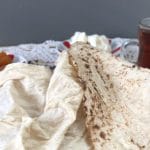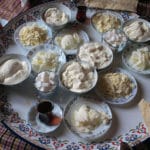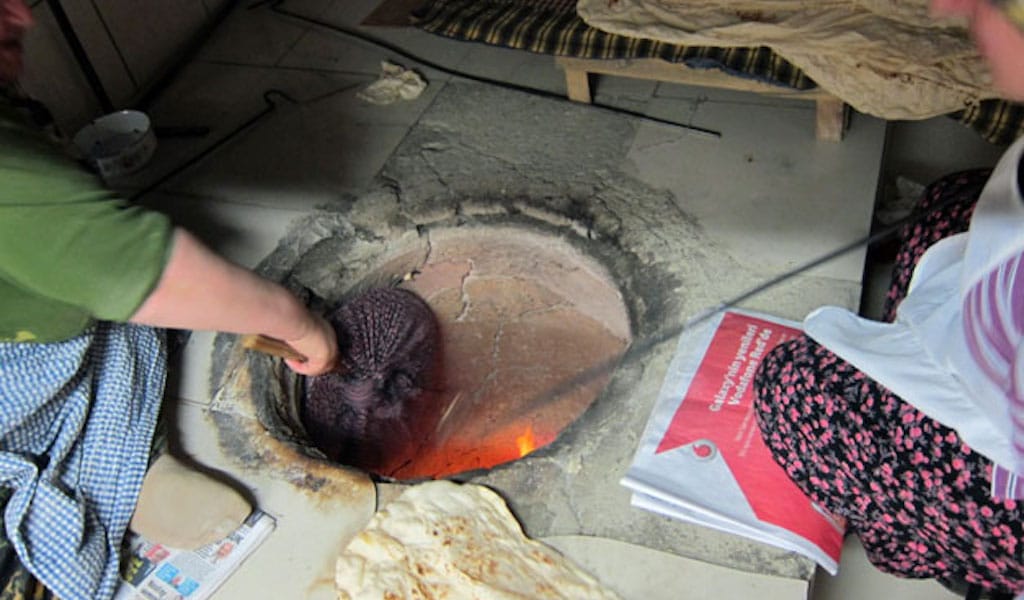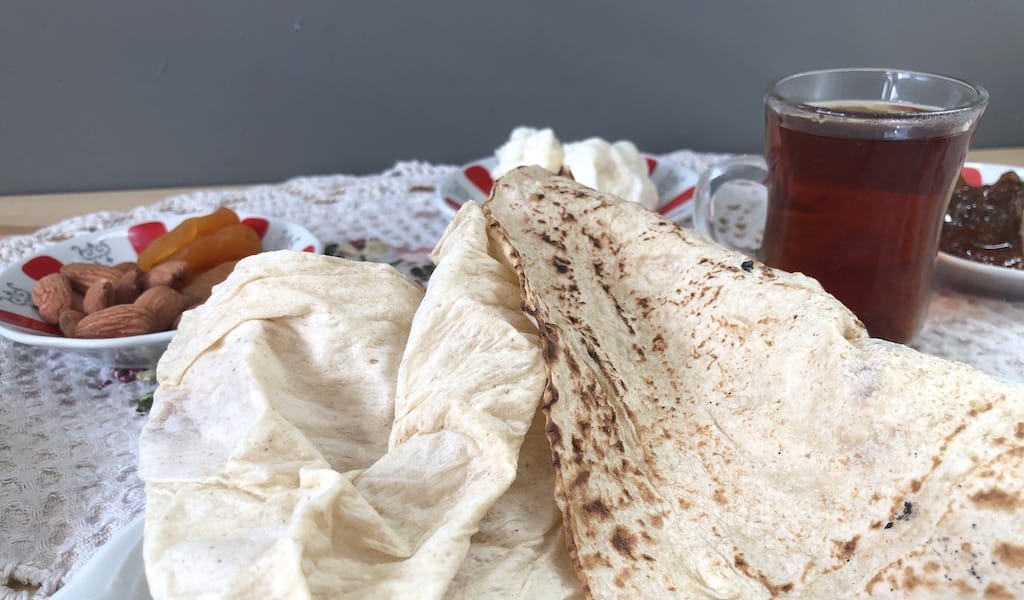In the Kurtuluş district of Istanbul, we’ve lately been exploring links to older, nearly lost Istanbul culinary traditions. Spending time in the sweetshops, milk bars and şarküteri of this district, we’ve seen a glimmer, if faded, of the “Old Istanbul” that people remember from the 1950s and ’60s, when the city’s historic minorities – Greeks, Armenians and Jews – played a prominent role in the culinary scene of the city. A time before this city became, as one local Greek Kurtuluş resident not so tactfully put it, “one great big Kebabistan.” It’s a complex and endlessly fascinating subject, one that never fails to spark our curiosity.
And then we were distracted by the smell of fresh bread.
Fresh lavaş, to be more specific, being hoisted out of a fiery hole in the floor on a blackened hook by the sturdy Gül Hanım, dressed not in baker’s whites but in a wild floral collage of patterns that was covering her headscarf, billowy pants and shirt. Working right across the pit from her was a similarly clad (and sturdy) Şükriye Hanım, who gave the dough a final spin and stretch before patting it onto the wall of the brick with a paddle that had a wide round cushion on its end. Then there was Ayfer, who, much to Şükriye’s chagrin, sat in a chair before a machine that rolled out paper-thin ovals of dough. “What, you don’t have hands?” Şükriye said teasingly. The fan of the hood above these women roared, the paddle thumped and the hook scraped against the wall of the oven as the three bakers all cackled and jabbed in loud voices.
This scene unfolded just behind a cooler stocked with the holy grail of the eastern Turkish province of Erzincan: raw sheep’s milk cheese packed into an animal hide. The owner’s daughter, Elif, explained that all the materials used here were brought in from the town of İliç in Erzincan (home of Chobani yogurt founder Hamdi Ulukaya, whom we wrote about last year). The bakery sells tulum cheese and sheep’s butter, erişte, a broad flat noodle made from wheat flour (bused in from Erzincan), honey fragrant with the wildflowers that carpet the mountainside outside of İliç and, of course, lavaş. The women, likewise, were also imports from the villages surrounding İliç. They came from sheepherding families and grew up in the high mountain pastures milking sheep and making cheese. Working the tandır oven was something done down in the village, where most homes had one. So here in Kurtuluş, they are doing what comes naturally.
“We have all sorts of customers. Foreigners too,” said Elif.
Foreigners?
“Armenians and other people not from Erzincan. They all buy our lavaş,” she said.
 Though this is more of a takeaway operation, where small restaurants and neighborhood residents come to get fresh lavaş, a table and chairs are set up in the front, next to where the erişte is made. For us, Elif scooped a generous mound of tulum onto a steaming lavaş and rolled it up to make a wrap. We took this snack over to our table to meditate on this incredible little slice of country life in Kurtuluş, our supposed fortress of the Old Istanbul kitchen. Chewy lavaş like a moonscape – crispy charred bubbles and swirls where Şükriye’s thumb pulled the dough extra thin – wrapped around the equally otherworldly cheese, with its sharp, metallic zing to the tongue, almost like licking a nine-volt battery, then giving way to the cheese’s rich and creamy side. This, along with the newspaper laid out as a tablecloth, was exactly what we’d experienced in Erzincan just a few months back.
Though this is more of a takeaway operation, where small restaurants and neighborhood residents come to get fresh lavaş, a table and chairs are set up in the front, next to where the erişte is made. For us, Elif scooped a generous mound of tulum onto a steaming lavaş and rolled it up to make a wrap. We took this snack over to our table to meditate on this incredible little slice of country life in Kurtuluş, our supposed fortress of the Old Istanbul kitchen. Chewy lavaş like a moonscape – crispy charred bubbles and swirls where Şükriye’s thumb pulled the dough extra thin – wrapped around the equally otherworldly cheese, with its sharp, metallic zing to the tongue, almost like licking a nine-volt battery, then giving way to the cheese’s rich and creamy side. This, along with the newspaper laid out as a tablecloth, was exactly what we’d experienced in Erzincan just a few months back.
An aged Armenian meze master just around the corner had earlier posed the question, “How can you make Istanbul Armenian cuisine if you grow up on a mountain eating cheese and flat bread?” He was speaking of the patrimony of “Eski Istanbul,” a term that is often code for Armenian, Greek and Jewish culinary influences, but what he was really objecting to was his competitors, Kurdish men from eastern Turkey’s Van, doing a brisk business in mezes down the street. Yet these culinary interlopers are simply part of a long and tangled history of migrations. There was a time when the Greeks, migrants from the island of Chios, were newcomers to this area. And after that, Armenians, and then those from Erzincan and more recently Nigerians, who have become an object of interest on the nearby Feriköy soccer field.
As we chomped and tugged at our rolled-up cheese sandwich, the urgency of our research into what was eaten in Old Istanbul and who could lay claim to it as their heritage all dissolved away. Boş ver, as they say in Turkish. Let it go. Istanbul’s living kitchen was right here with these transplants from Erzincan sitting around a raging fire. They might not know how to make classic Istanbul mezes, but they are contributing something relevant of their own to the city’s collective culinary heritage. Based on the steady stream of locals coming through the door to pick up oven-fresh lavaş, the city – us included – seems to approve.
Editor’s note: To celebrate the ‘Year of the Neighborhood,’ we will be republishing dispatches from the less-visited areas – like Kurtuluş – that our correspondents are planning to explore this year.
 December 23, 2020 Essential Bites
December 23, 2020 Essential Bites
Müşterek’s Mezes on the Move
Müşterek has been my favorite meyhane for quite some […] Posted in Istanbul December 13, 2013 CB on the Road
December 13, 2013 CB on the Road
Like many other Central Anatolian cities, Erzincan is one of those places with very […] Posted in Istanbul February 13, 2024 Bywater Bakery
February 13, 2024 Bywater Bakery
In the spring of 2017, the Bywater Bakery opened its doors and became something of an […] Posted in New Orleans
Published on March 02, 2018
Related stories
December 23, 2020
IstanbulMüşterek’s Mezes on the Move Müşterek has been my favorite meyhane for quite some time, but I’ve been less than vocal about this in public. During its heyday, it could be tough to get a table in the cozy space even on a weekday, so I preferred to keep mum about this beloved spot on…
December 13, 2013
IstanbulLike many other Central Anatolian cities, Erzincan is one of those places with very little there there. The natural setting – on a high plateau and ringed by craggy peaks – is promising, but the town itself feels like it’s been scrubbed clean of all traces of history or local distinctiveness, its streets lined with…
February 13, 2024
New Orleans | By Pableaux Johnson
New OrleansIn the spring of 2017, the Bywater Bakery opened its doors and became something of an “instant institution.” Part casual restaurant and part impromptu community center, the cafe space hummed with perpetual activity. Deadline-racked freelancers posted up with their laptops, soon to be covered in butter-rich pastry flakes. Neighborhood regulars would crowd tables for a…


















































































